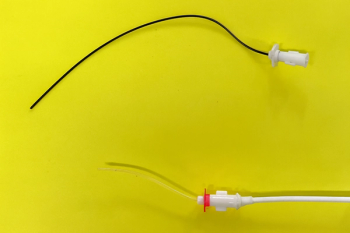
What's your diagnosis? A urinalysis challenge
How would you interpret the results in these seven case presentations?
How would you interpret the results in these seven case presentations?
The following questions are designed to facilitate self-assessment of your interpretation of urinalyses of several patients admitted to the Veterinary Teaching Hospital at the University of Minnesota. When choosing your answer, remember to distinguish between observations and interpretations and to consider the most appropriate answer in terms of probabilities rather than possibilities. (Note: hpf means high-power microscopic field, or 450X; lpf means low-power microscopic field, or 100X).
Urinalysis results of a voided sample from a 2-year-old neutered male English bulldog (sample refrigerated immediately after collection):
- Color = yellow
- Turbidity = clear
- Specific gravity = 1.031
- pH = 6.0
- Glucose = negative
- Acetone = negative
- Bilirubin = negative
- Occult blood = negative
- Protein = trace
- RBC = 1-2/hpf
- WBC = 0-1/hpf
- Casts = none
- Epithelial cells = occasional
- Bacteria = none
- Crystals = few ammonium urate
Which is the most appropriate interpretation of these results?
Urinalysis results of a voided sample from a 9-year-old spayed female boxer:
- Color = light yellow
- Turbidity = clear
- Specific gravity = 1.003
- pH = 6.5
- Glucose = negative
- Acetone = negative
- Occult blood = negative
- Protein = negative
- RBC = negative
- WBC = negative
- Casts = none
- Epithelial cells = none
- Bacteria = none
Which is the most appropriate interpretation of these results?
Urinalysis results of a sample collected by cystocentesis from a 10-year-old spayed female basset hound:
- Color = yellow
- Turbidity = cloudy
- Specific gravity = 1.029
- pH = 8.5
- Glucose = negative
- Acetone = negative
- Occult blood = 4+
- Protein =2+
- RBC = 200/hpf
- WBC = 200/hpf
- Casts = none
- Epithelial cells = occasional
- Bacteria = numerous rods
- Crystals = many struvite
Which is the most likely diagnosis?
Urinalysis results of a sample collected by cystocentesis from a 2-year-old spayed female domestic shorthaired cat:
- Color = light yellow
- Turbidity = slightly cloudy
- Specific gravity = 1.014
- pH = 6.0
- Glucose = negative
- Acetone = negative
- Bilirubin = negative
- Occult blood = 2+
- Protein = 2+
- RBC = 20-30/hpf
- WBC = 20-30/hpf
- Casts = occasional WBC/lpf
- Epithelial cells = moderate
- Bacteria = many cocci
- Crystals = none
This patient has an infectious inflammatory disease most likely involving which of the following (pick the best answer)?
Urinalysis results of a sample collected by catheterization from a 4-year-old neutered male Alaskan malamute:
- Color = pink
- Turbidity = slightly turbid
- Specific gravity = 1.035
- pH = 7.0
- Glucose = negative
- Acetone = negative
- Occult blood = 3+
- Protein = 3+
- RBC = > 100/hpf
- WBC = 0 to 1/hpf
- Casts = none
- Epithelial cells = occasional
- Bacteria = none
- Crystals = occasional struvite
Which is the most likely diagnosis?
Urinalysis results of a voided sample collected from a 2-year-old neutered male Norwegian elkhound:
- Color = yellow
- Turbidity = slightly cloudy
- Specific gravity = 1.016
- pH = 6.5
- Glucose = 2+
- Acetone = negative
- Bilirubin = negative
- Occult blood = negative
- Protein = negative
- RBC = 0-1/hpf
- WBC = none
- Casts = none
- Epithelial cells = moderate
- Bacteria = negative
- Crystals = negative
Which is the most likely cause of these findings?
Urinalysis results of a voided sample collected from a 15-year-old female cat:
- Color = light yellow
- Turbidity = clear
- Specific gravity = 1.022
- pH = 5.5
- Glucose = negative
- Acetone = negative
- Bilirubin = negative
- Protein = negative
- RBC = none
- WBC = occasional
- Casts = negative
- Epithelial cells = occasional
- Bacteria = negative
- Crystals = none
Which is the most appropriate interpretation of these results?
Newsletter
From exam room tips to practice management insights, get trusted veterinary news delivered straight to your inbox—subscribe to dvm360.





